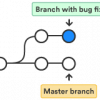 |
5 Key Factors to Achieve Agile Testing in DevOps Part of the path to DevOps requires adoption of agile methodologies. What does it mean for testing when you switch from the traditional waterfall model, with a few long release cycles per year, to the agile model, with changes occurring every two weeks? Here are five key factors to achieve the agile software testing necessary in DevOps. |
|
 |
Agile Estimates versus #NoEstimates: Bridging the Gap Agile teams can easily get puzzled by the heated debate happening between advocates for estimation and those in the #NoEstimates camp. However, by comparing how they solve these problems, we can identify many common practices between the two groups and see they are not truly at odds—they actually complement each other. Let's bridge the gap. |
|
 |
Agile Development: Focusing on the Health of Your Code In Scrum, the product owner and the ScrumMaster are supposed to drive sustainable development. But there's a third force missing from the formula: the health of the code itself. We often forget that our code is also a member of our team, and we have to be concerned about its health and well-being as much as any other team member. That means using practices to develop good code from the beginning. |
|
 |
Picking the Right Branch-Merge Strategy A good branch-merge strategy facilitates processes among multiple developers and is the basis for any well-functioning DevOps pipeline that uses continuous integration. Let’s explore branching strategies, merging strategies, and how you can put them together in a way that’s right for your team in order to bring quality features to production faster. |
|
 |
3 Elusive Qualities of a Great Product Owner When it comes to guiding the development of a product and ensuring you’re building what the user actually needs, a product owner is the most important hire for the team. There’s just one problem: A good product owner can be really hard to find. The characteristics that make a good product owner are elusive, but here are three qualities you should prioritize in your search. |
|
 |
5 Ways ScrumMasters Can Enhance Daily Standups Daily standup meetings can turn into a perfunctory chore, with everyone simply going through the motions. It’s the ScrumMaster’s job to make sure that doesn’t happen and the meetings remain useful for everyone. With these five ideas, the ScrumMaster can actively help daily scrums be effective and encourage communication, transparency, and efficient delivery of value. |
|
 |
Eliminate Fake Certainty and Solve the Real Problem Too often, customers have a “fake certainty” about the problems they want to solve. They might not have defined the real problem, but they have frequently defined the solution anyway. The risk is that we might build the wrong thing. When the product owner works with the customers to define the problem, then works with the team to define the solution, everyone can win. |
|
|
|
3 Methods for Better Communication and More Effective Testing Successful delivery of software requires the entire team, so it’s imperative that everyone choose their words carefully so they convey what they really mean, are sensitive to others’ feelings, and consider all aspects of a problem. Here are three questions to remember when communicating about your software testing projects to ensure you’re considering the power of words. |
|
 |
Software Development: An Industry of Amateurs David Bernstein says the software industry is an industry of amateurs. It's a young field, and he doesn’t think it's yet graduated into a true profession. Here, David contrasts the software industry with other, more established fields, and he talks about what software professionals need to do in order for the industry to become accepted and esteemed. |
|
 |
Why You Need Continuous Testing in DevOps DevOps is more than adopting the right set of tools; it's a cultural shift that incorporates testing at each stage of the agile project lifecycle. Continuous testing is key to unlocking this culture change because it weaves testing activities into every part of the software design, development, and deployment processes, which helps everyone involved communicate more, collaborate better, and innovate faster. |
Pages
Upcoming Events
| Jun 02 |
AI Con USA Bridging Minds and Machines |
| Sep 22 |
STARWEST Software Testing Conference in Anaheim & Online |
| Oct 13 |
Agile + DevOps USA The Conference for Agile and DevOps Professionals |











